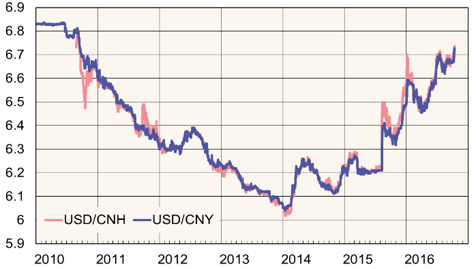BOFIT Weekly Review 41/2016
Yuan’s exchange rate volatility increases after addition to SDR basket
The yuan lost about 1 % of its value against the dollar when the markets reopened this week after the week-long National Day celebrations. In September, the yuan was relatively stable and its inclusion in the IMF’s SDR basket on October 1 went without a hitch. Capital outflows from China have continued as the yuan has weakened. The country’s foreign currency reserves this year have shed $164 billion and at the end of September stood at $3.166 trillion.
An increase in yuan exchange rate volatility reflects the policy goal of a free-floating currency. The yuan’s average daily variation against the dollar has been 0.12 % over the past year. It was 0.07 % prior to the exchange rate reform of summer 2015. Even with the yuan’s higher exchange rate volatility, it still fluctuates considerably less than free-floating currencies. The euro’s daily average fluctuation this year has been 0.41 % and the yen’s 0.52 % against the dollar. The average change in offshore yuan (CNH) against the dollar has also been larger (0.17 %) than for the onshore CNY rate. The largest single daily change in the yuan’s exchange rate – 1.8 % – occurred in August 2015 in connection with the exchange rate reform. For comparison, on the day after the Brexit vote, the euro lost 2.1 % and the yen appreciated 3.4 %.
Onshore vs. offshore rates: CNY and CNH (HK) against USD

Source: Macrobond.